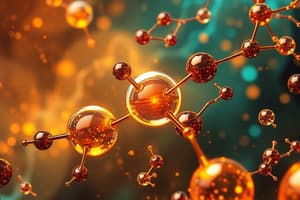Podcast
Questions and Answers
What are the two main types of isomers in organic chemistry?
What are the two main types of isomers in organic chemistry?
Structural and stereoisomers
Explain the difference between structural and stereoisomers.
Explain the difference between structural and stereoisomers.
Structural isomers have different bond arrangements, while stereoisomers have the same bond pattern but differ in spatial arrangement of atoms.
What is the term for compounds that have identical chemical bond patterns but differ in spatial arrangement?
What is the term for compounds that have identical chemical bond patterns but differ in spatial arrangement?
Stereoisomers
What are polymers made up of carbon compounds called?
What are polymers made up of carbon compounds called?
How do organic compounds typically compare to nonorganic materials like metals in terms of melting points?
How do organic compounds typically compare to nonorganic materials like metals in terms of melting points?
What type of hydrocarbons feature linear or branched chains?
What type of hydrocarbons feature linear or branched chains?
How does polymerization affect the properties of materials?
How does polymerization affect the properties of materials?
What is the common functional group found in alcohol?
What is the common functional group found in alcohol?
Give an example of a polymer mentioned in the text.
Give an example of a polymer mentioned in the text.
What type of hydrocarbons involve a planar six-membered ring with alternating single and double bonds?
What type of hydrocarbons involve a planar six-membered ring with alternating single and double bonds?
Flashcards are hidden until you start studying
Study Notes
Carbon compounds form the backbone of many organic molecules found in nature. They consist mainly of carbon atoms bonded together through covalent bonds with other elements such as oxygen, nitrogen, sulfur, phosphorus, and halogens. Some common properties shared by all organic compounds include their ability to undergo combustion reactions, dissolve easily in polar solvents, and have relatively low melting points compared to nonorganic materials like metals. Organic compounds also tend to be biodegradable, which means they can be broken down into simpler components through natural biological processes.
Isomers in Carbon Compounds
Isomers refer to different structures of a single molecular formula, usually due to differences in the placement of atoms within the structure. There are two main types of isomers in organic chemistry: structural and stereoisomers. Structural isomers differ from one another based on the arrangement of their chemical bonds; for example, alkyl chains joined to aromatic rings versus straight chain alkenes. Stereoisomers, on the other hand, differ only in how their atoms are arranged in space, even though they may share identical chemical bond patterns. For instance, a compound might have both left-handed and right-handed versions known as enantiomers, a type of stereoisomer.
Polymers of Carbon Compounds
Polymers made up of carbon compounds are called polymeric hydrocarbons. These large molecules contain repeating units built around central core structures consisting of conjugated double and triple bonds between carbon atoms. Polymerization occurs when monomers combine to form longer chains or branched structures, leading to changes in the material's properties such as hardness, flexibility, strength, and durability. Examples of these polymers include polyethylene (PE), polypropylene (PP), acrylonitrile-butadiene-styrene copolymer (ABS), polytetrafluoroethylene (PTFE), and more.
Hydrocarbons in Carbon Compounds
Hydrocarbons belong to the class of organic chemical compounds containing solely carbon and hydrogen atoms in various combinations. Aliphatic hydrocarbons feature linear or branched chains while cycloaliphatic hydrocarbons possess ring structures. Aromatics, also known as arenes, involve a planar six-membered ring with alternating single and double bonds. Simple unsaturated hydrocarbons include ethane, propane, and ethylenes, whereas complex saturated hydrocarbons include naphthalene, anthracene, phenanthrene, etc. The compositions of hydrocarbons vary widely depending upon the number and kind of carbon atoms present.
Functional Groups in Carbon Compounds
Functional groups play crucial roles in determining the reactivity of carbon compounds towards specific chemical reactions. Common functional groups include alcohol (-OH group), ether (-OR group), amine (-NH2 group), carboxylic acid (-COOH group), ester (-OCOR group), ketone (-C=O group), and carbonyl group (-CCR'). Functional groups provide sites where chemical bonds can break apart during a reaction, thus allowing atoms to rearrange themselves to create new products, often with very different physical and chemical properties.
In summary, carbon compounds exhibit unique features related to isomers, polymer formation, and the presence of functional groups. Understanding these aspects allows chemists to manipulate and synthesize diverse carbon compounds that serve important purposes across numerous industries.
Studying That Suits You
Use AI to generate personalized quizzes and flashcards to suit your learning preferences.




